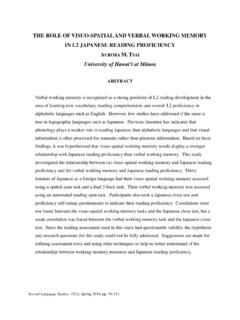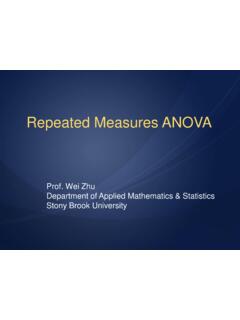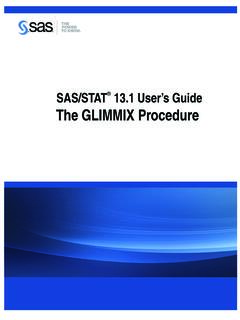Transcription of “Mixed Reviews”: An Introduction to Proc Mixed
1 ANNMARIA DE MARS, JULIA GROUPSANTA MONICA, CA Mixed Reviews :An Introduction to Proc MixedObligatory naked mole rat slide How to do PROC Mixed , syntax using SAS and SAS Enterprise Guide, Interpretation of PROC Mixed results, Differences between PROC Mixed and PROC GLM, Common error messagesStatisticians feel free to check your text messages I see a significant R-squared, can I leave now? It s not as hard as it looksProc Mixed , that isIn a nutshell For the vast majority of practical cases, PROC Mixed and PROC GLM will give you the same results If you aren t familiar with PROC GLM, the previous statement was of no help whatsoeverBaby StepsGLM = General Linear Model Regression Analysis of VariancePROC Mixed and PROC GLM bothAre used to predict the values of a numeric dependent variable Assume the dependent variable is normally distributedPROC GLM may beidentical to PROC MIXEDMIXED MODELS include A mix of FIXED effects and RANDOM effects Seriously, this is key to understanding the whole thingThese variables can be either qualitative (as in the traditional analysis of variance) or quantitative (as in standard linear regression).
2 SAS SAS/STAT Users Guide The fixed-effects parameters are associated with known explanatory variables, as in the standard linear model. Fixed effectNot a random sample of gendersRandom effects -schoolsWell, either type of school, reallyWhy age is not a random effectIt s all about the (error)variancePredicting height of a new species Family is a random effect Age is notWhy PROC Mixed may not matterIt may be that there is not much covariance within schools, sites, Mixed Models differY = 1* FAM_INC + 2*SCHOOL + 3 *IQ + eIID* and homoscedasticity* Independent, identically distributed In PROC Mixed , errors are not assumed to be uncorrelatedGLM assumes errors are uncorrelated, homoscedasticand normally distributed That s IT ?!You went through this whole thing to say that in PROC GLM errors are assumed to be uncorrelated and in PROC Mixed they re not?
3 How Mixed Models differY = 1* FAM_INC + 2 *IQ + YZ1 + eBut in this case eis no longer assumed to be independentAlso, there can be (and usually are) a bunch of gamma effectsOne last try .. In the general model PROC GLM we are trying to fit meansIn the Mixed In addition to means, we are trying to fit covariances. We don t have to worry about that with the general linear model because we have assumed that all the observations are independent and thus there is no last statistical pointYes, it is really the last oneCrossed versus nested factorsOften, in PROC Mixed you ll need to specify if your data are nested Crossed factors: Each level of each factor appears in every other levelMarital status and employmentNested factorsSubjects are usually NESTED within group. A subject will be either an experimental group or a control example and syntax at last!
4 We want to test for differences between control and experimental groups. We d like to take into account our repeated measures, so when we compare our groups later we can say that any differences are due to our wonderful Mixed DATA = Mixed ;CLASS group name pre_post;MODEL score = group pre_postgroup*pre_post; repeated pre_post/ SUBJECT = name(group) TYPE = cs;LSMEANS group group*pre_post/ adjust = tukey;That s IT ? , for each statement ..PROC Mixed DATA = Mixed ;Okay, that s pretty self-evidentIdentify your categorical variables in the class statement. This INCLUDES your subject identifierCLASS group name pre_post;Model dependent = FIXED EFFECTS ;MODEL score = group pre_postgroup*pre_post;Specify the variable that is repeatedSpecify the variable that identifies the subject AND IF IT IS NESTED Subject-identifier (variable it is nested within) You don t have to specify a covariance structure typeREPEATED pre_post/ SUBJECT = name(group) TYPE = cs;LSMEANS requests the means for the variables and subgroups specified/ adjust = requests test of differences between means LSMEANS group group*pre_post/ adjust = tukey; output !
5 There were no random effectsIn this exampleshouldbe 2 * # of subjectsConvergence criteria metHere is the estimate for the covariance due toName (within subjects), the type of covariance matrix is compound symmetry. AkakikeInformation CriterionFit statistics are used to compare models. If I re-ran the model without one of the variables, I could see if the resulting model was better or your model better than nothing?Type 3 test of FIXED EFFECTSWhat hypothesis is being tested?THIS IS REALLY IMPORTANT !!! Test of Mean DifferencesNOTE: Dataset is structured differentlyPROC Mixed multiple observations per subject PROC GLM one observation per subject, with multiple fields for test scoreCompared to PROC GLMGLMMIXEDThe less than exciting pointIt is not a very huge difference whether you use PROC GLM or PROC MIXEDHow about RANDOM effects ?
6 Maybe that will be better?Curriculum tested at three sites with pretest and posttestRANDOM effect = schoolREPEATED = trialAt last! More syntax!proc Mixed data = mixedRratio ;class site trial case ;model score = trial ;Random site / subject = case(site); repeated trial ;lsmeanstrial / adjust = tukey;NOTE Model score = trial ;Only fixed effects on model statementSite is a random effectRandom site / subject = case(site); repeated trial ;We are happySeriously, what difference does it make? Sometimes you can use RANDOM or repeated Sometimes RANDOM doesn t matterRandom & RepeatedAre not the same except when they overspecifiedmodels .. can be specified by using a randomor repeatedstatement alone. Unfortunately, one such model is the commonly encountered repeated measures with compound symmetry.
7 May not matterConceptually, you have a random effect if it is sampled from the population of individuals, machines, schools, , a random effects explains some of the covariance. If there is not any difference among the families/ schools / sites in your sample, the RANDOM statement won t no programmingRepeated Measures ANOVA using Proc MixedPre-Post Test ExperimentA typical experimental design subjects were either an experimental group or control groups were given a pre-test and a want to test for significance of interaction between group and test. Your hypothesis is that such an interaction exists and the experimental group improved to do & how to do it You could do a Mixed model ANOVA It is called Mixed because it has two types of effects, fixed and random Your data should be in the format of one record for EACH measurement for each person, , multiple records per person.
8 Select Mixed MODELS taskMixed on ZSCORE under dependent NAMEID PRE_POST & GROUP under classificationMixed Model: FIXED EFFECTS GROUP & PRE_POST and click on the GROUP & PRE_POST at the same timeby holding down the shift key and click on the CrossbuttonMixed Model: on repeated on the .. next to Subject NAMEID as the Subject Model: on Name, the NEST button will no longer be grayed on NESTM istakes not to though it makes perfect sense to think of the subject identifier as a random effect (which it is) do NOT identify it as a random effect. The random effect is for random effects that are not repeated . In this example, there were no such random the difference between crossed & nested effects. Here we have both crossed and nested effects point !Sorry, but.
9 Whether you use repeated vsRANDOM, the type of covariance, whether you use PROC GLM vsPROC Mixed . None of it matters a great deal unless your model is borderline. What does matter is if your model is completely WRONG, that is if you leave out the repeated effects, don t realize that subjects are nested within schoolsSo, Chris Rock was wrong. You need to know why*



















